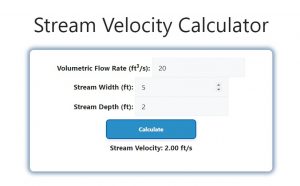About Stream Velocity Calculator (Formula)
Understanding stream velocity is essential for various environmental studies, including water quality assessment, sediment transport, and habitat analysis. The Stream Velocity Calculator enables users to easily determine the velocity of water flow based on key parameters. In this article, we will explore the formula used for calculating stream velocity, how to use the calculator effectively, provide a practical example, and answer frequently asked questions to enhance your understanding of this important concept.
Formula
The formula for calculating stream velocity (SV) is:
Stream Velocity (SV) = Volumetric Flow Rate / (Stream Width * Stream Depth)
This equation provides a straightforward way to quantify how quickly water is flowing through a stream.
How to Use
Using the Stream Velocity Calculator is simple. Follow these steps:
- Determine the Volumetric Flow Rate: Measure or obtain the volumetric flow rate of the water, usually expressed in cubic meters per second (m³/s).
- Measure Stream Width: Measure the width of the stream at the point of interest in meters.
- Measure Stream Depth: Measure the depth of the stream at the same point in meters.
- Input Values: Enter the volumetric flow rate, stream width, and stream depth into the calculator.
- Calculate Stream Velocity: The calculator will compute the stream velocity based on the input values.
- Review the Result: The output will indicate the velocity of the water flow, helping in further analysis.
Example
Let’s say you have a stream with a volumetric flow rate of 20 m³/s, a width of 5 meters, and a depth of 2 meters. To calculate the stream velocity:
Stream Velocity (SV) = Volumetric Flow Rate / (Stream Width * Stream Depth)
Stream Velocity (SV) = 20 m³/s / (5 m * 2 m)
Stream Velocity (SV) = 20 m³/s / 10 m²
Stream Velocity (SV) = 2 m/s
So, the stream velocity would be 2 meters per second.

FAQs
- What is stream velocity?
Stream velocity is the speed at which water flows through a stream or river, typically measured in meters per second (m/s). - Why is stream velocity important?
It influences sediment transport, aquatic habitats, water quality, and overall river health. - How do I measure the volumetric flow rate?
You can measure flow rate using various methods, including flow meters, weirs, or by calculating the cross-sectional area and velocity of the water. - Can I use this calculator for different types of water bodies?
Yes, it can be applied to rivers, streams, and canals, as long as you have the required measurements. - What units are used in the calculator?
The calculator typically uses cubic meters per second (m³/s) for flow rate and meters for width and depth. - How does stream velocity affect aquatic life?
Different species thrive at varying velocities; some require faster flows for spawning, while others prefer slower waters. - Can stream velocity impact water quality?
Yes, higher velocities can lead to increased aeration and pollutant dispersion, while slower velocities may result in stagnation and lower oxygen levels. - What factors can affect stream velocity?
Factors include stream gradient, obstructions, channel shape, and the presence of vegetation. - How often should I measure stream velocity?
Regular monitoring is essential, especially during different seasons and after significant weather events. - What is the relationship between stream width, depth, and velocity?
Wider and deeper streams typically allow for a larger volumetric flow rate, affecting the calculated velocity. - Can I calculate stream velocity in different environmental conditions?
Yes, but it’s essential to consider changes in flow rate due to rainfall, snowmelt, or drought conditions. - How does the calculator help in environmental studies?
It provides quick and accurate assessments of water flow, which is crucial for habitat conservation and pollution management. - What are the potential limitations of using this calculator?
It may not account for variations in flow due to weather or human activities, so field verification is recommended. - Is there a specific range for healthy stream velocities?
Healthy stream velocities vary by ecosystem; generally, moderate flows support diverse aquatic life. - How can I ensure accurate measurements?
Use calibrated instruments and take multiple readings to account for variability. - Can stream velocity affect sediment transport?
Yes, higher velocities can erode banks and carry larger sediments, while lower velocities may deposit sediments. - What role does stream velocity play in flood management?
Understanding velocities helps predict flood behavior and manage flood risks in surrounding areas. - Are there tools available to measure stream velocity?
Yes, devices like acoustic Doppler current profilers (ADCP) and flow meters can provide accurate measurements. - How does human activity impact stream velocity?
Urbanization, damming, and land use changes can significantly alter natural flow patterns and velocities. - What resources are available for learning more about stream velocity?
Environmental organizations, academic institutions, and governmental agencies often provide educational materials and resources.
Conclusion
The Stream Velocity Calculator is an essential tool for environmental scientists, hydrologists, and anyone involved in water resource management. By accurately determining stream velocity, users can gain valuable insights into water flow dynamics, sediment transport, and aquatic ecosystems. Understanding how to use this calculator and the factors affecting stream velocity will enable better decision-making and foster effective water management practices.
